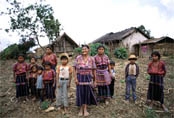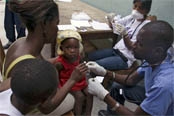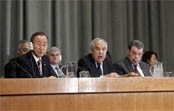
Indigenous peoples are the caretakers of some of the world’s most diverse territories. However, in many countries, they face discrimination and conflict on a daily basis. The United Nations has continually provided opportunities for indigenous peoples to have their voices heard at the international level. One of the major achievements in recent years was the adoption of the United Nations Declaration on the Rights of Indigenous Peoples, which was voted for in the General Assembly in 2007.
The United Nations Permanent Forum on Indigenous Issues (UNPFII) was established by the United Nations Economic and Social Council (ECOSOC) resolution 2000/22 on 28 July 2000. To substantiate this work, the Permanent Forum was called upon to provide expert advice and recommendations on indigenous issues to the United Nations system and to raise awareness and promote the integration of relevant activities within the UN system.
The Permanent Forum is comprised of sixteen independent experts who serve for a term of three years as Members and may be re-elected or re-appointed for one additional term. Eight of the Members are nominated by Governments and the other eight are nominated directly by indigenous organizations in their regions. The Members nominated by Governments are elected by the Economic and Social Council (ECOSOC) based on five regional groupings of States normally used at the United Nations.
Each year UNPFII meets for 10 days in New York. The meeting focuses on important matters related to indigenous peoples such as economic and social development issues, environment, cultural issues, health and human rights. This year’s session, which will take place from 19-30 April, has a special theme entitled “Indigenous peoples: development with culture and identity; articles 3 and 32 of the United Nations Declaration on the Rights of Indigenous Peoples”.
UNPFII takes on the plight of indigenous peoples
One of the most common issues faced by indigenous peoples across the world are the barriers which prevent them from becoming custodians of their own land. Developmental activities continue to impose large infrastructure projects on their lands without their free, prior and informed consent. As a result, poverty, inequality and massive environmental devastation ensue. This has often been cited as a gross violation of their human rights.
Indigenous peoples can be hesitant towards such Western concepts as “globalization” and “development”. For many indigenous peoples (as noted in previous sessions of the UNPFII) globalization is viewed as “an aggressive attempt to shape national economies to mimic the economic system of the industrialized countries and which is grossly unjust and has promoted further inequality and environmental devastation within a short period of time”.
Furthermore, indigenous peoples’ own governance, economic, social, education, cultural, spiritual and knowledge systems and their natural resources have sustained them through generations. Rupturing the fabric of their social life through these violating tendencies often harms indigenous communities.
Guarani people and their fundamental rights
As part of its human rights agenda, the Permanent Forum will engage in separate dialogues with the Governments of Bolivia and Paraguay to follow-up to the missions undertaken by the Forum to both countries in early 2009.
The missions focused on the situations of forced labour faced by Guarani people of the Chaco regions of both countries. The region’s complex political economy coupled with the highly concentrated nature of land ownership has complicated matters for indigenous peoples. The lands that are in the middle of the dispute have either been recognized or are being claimed by the Guarani peoples.
In the case of Bolivia, these lands are often in the middle of vast estates containing important reserves of hydrocarbons and are crossed by gas pipelines owned by oil companies. This is a source of extensive wealth but unfortunately the Guarani people receive little or no benefit from it. Furthermore, the situation has intensified the amount of tension between the Government and local authorities. With the country’s richest resources in question, local authorities in cooperation with big landowners are fighting for control of the resources and looking for higher degree of autonomy from the Government.
In both Bolivia and Paraguay, landowners operate with inexpensive indigenous labour. As a result, forced labour, child labour, poor working conditions, the loss of and consequent lack of access to lands, the non-existence of social services, and restrictions on the right to freedom from association and discrimination are some of the discriminatory predicaments arising from this situation. The reports and recommendations of the missions undertaken by the Permanent Forum concentrate on these issues and more. This year’s session will address such concerns.
Special side events at UNPFII
Like every year, this session of UNPFII will have some special side events where different indigenous organizations take part to discuss issues that affect them at the local level. For instance, the United States Agency for International Development is one of the participants who will conduct a Panel Discussion on USAID in Latin America. They will display and discuss the programmes that benefit Indigenous Peoples in Latin America with a period for questions and feedback from the audience to determine how programmes are utilized.
Another side event is the Global Environment Facility (GEF) Roundtable Discussion on Indigenous Peoples and Biodiversity. This particular event will highlight the emerging issues on indigenous peoples and biodiversity conservation and sustainable use on the occasion of the International Year on Biodiversity.
Indigenous peoples of the North American region
This year’ session will devote a half day to discuss some major issues pertaining to North America. In the USA and Canada, Indigenous peoples face discrimination and live with legacy of historical abuse related to colonization and forced assimilation policies. Some challenges faced by indigenous peoples of North America include disproportionately high levels of unemployment, lack of access to clean water supply, physical and social isolation, substandard and crowded housing and attacks on indigenous peoples’ cultural identity.
Assimilation tactics of the past, such as residential schools and adoption programs, have negatively impacted on indigenous peoples’ cultures, languages and traditions. Since 2006, several efforts by the Canadian government in particular have attempted reconciliation between the indigenous peoples and the Government.
The discrepancies between the lives of aboriginal and other North American women are quite daunting. Indigenous women in North America face disproportionately high rates of physical and sexual violence, and are often five times more likely to experience violent death than other North American women.
In Canada, approximately 500 aboriginal women have been murdered or reported missing over the past 15 years. Indigenous women are also overrepresented in North American prison systems and experience incidences of a range of health issues or illnesses, including diabetes, tuberculosis, HIV infection, obesity and hypertension at rates several times higher than those in the non-aboriginal population.
In addition, environmental concerns are widespread among indigenous peoples in the North American region. Rapid industrialization of the land and water has altered the natural relationships that have sustained indigenous peoples and their communities for centuries. As a result of these changes, health problems related to toxic chemicals and pollution have increased significantly.
The Special Rapporteur
Every year, the Special Rapporteur on the Situation of Human Rights and Fundamental Freedoms of Indigenous People, Professor James Anaya, holds individual meetings with representatives of indigenous peoples and organizations. This year, too, representatives of indigenous peoples and their organizations are expected to request a meeting with regard to matters that fall within the Special Rapporteur’s mandate and areas of work, including specific situations of alleged violations of indigenous peoples’ human rights.
More information The United Nations Permanent Forum on Indigenous Issues


